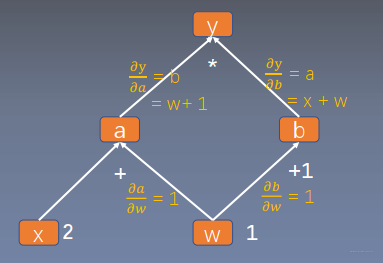一、自动求导(autograd)
1.1 torch.autograd.backward
torch.autograd.backward(tensors, grad_tensors=None, retain_graph=None,create_graph=False)
功能:自动求取梯度
- tensors: 用于求导的张量,如loss
- retain_graph : 保存计算图
- create-graph: 创建导数计算图,用于高阶求导
- grad_tensors: 多梯度权重的设置,用于多维loss
# -*- coding:utf-8 -*-
import torch
w = torch.tensor([1.], requires_grad=True)
x = torch.tensor([2.], requires_grad=True)
a = torch.add(w, x)
b = torch.add(w, 1)
y = torch.mul(a, b)
# 通过设置retain_graph=True,来再次使用计算图
y.backward(retain_graph=True)
print(w.grad)
y.backward()
注意: 计算图在第一次使用过后,会被系统释放掉,如果还想再次使用,则需要设置retain_graph=True
# -*- coding:utf-8 -*-
import torch
w = torch.tensor([1.], requires_grad=True)
x = torch.tensor([2.], requires_grad=True)
a = torch.add(w, x) # retain_grad()
b = torch.add(w, 1)
y0 = torch.mul(a, b) # y0 = (x+w) * (w+1)
y1 = torch.add(a, b) # y1 = (x+w) + (w+1) dy1/dw = 2
loss = torch.cat([y0, y1], dim=0) # [y0, y1]
grad_tensors = torch.tensor([1., 2.])
loss.backward(gradient=grad_tensors) # gradient 传入 torch.autograd.backward()中的grad_tensors
print(w.grad)
说明: 当损失函数维为多维时,可以通过设置 grad_tensors来设置每一维的权重,最终的损失维每一维的加权和
1.2 torch.autograd.grad
torch.autograd.grad(outputs,inputs,grad_outputs=None,retain graph=None,create_graph=False)
功能:求取梯度
- outputs: 用于求导的张量,如loss
- inputs: 需要梯度的张量
- create_graph: 创建导数计算图,用于高阶求导
- retain_graph: 保存计算图
- grad_outputs: 多梯度权重
x = torch.tensor([3.], requires_grad=True)
y = torch.pow(x, 2) # y = x**2
grad_1 = torch.autograd.grad(y, x, create_graph=True) # grad_1 = dy/dx = 2x = 2 * 3 = 6
print(grad_1)
grad_2 = torch.autograd.grad(grad_1[0], x) # grad_2 = d(dy/dx)/dx = d(2x)/dx = 2
print(grad_2)

注意:
- 梯度不自动清零
- 依赖于叶子结点的结点, requires-grad默认为True
- 叶子结点不可执行in-place操作
# 梯度不自动清零
w = torch.tensor([1.], requires_grad=True)
x = torch.tensor([2.], requires_grad=True)
for i in range(4):
a = torch.add(w, x)
b = torch.add(w, 1)
y = torch.mul(a, b)
y.backward()
print(w.grad)
# w.grad.zero_() # 手动设置对梯度清理

# 依赖于叶子结点的结点, requires-grad默认为True
w = torch.tensor([1.], requires_grad=True)
x = torch.tensor([2.], requires_grad=True)
a = torch.add(w, x)
b = torch.add(w, 1)
y = torch.mul(a, b)
print(a.requires_grad, b.requires_grad, y.requires_grad)

# in-place操作
a = torch.ones((1,))
print(id(a), a)
# a = a + torch.ones((1, ))
# print(id(a), a)
a += torch.ones((1,)) # in-place操作,处理的是同一块内存地址
print(id(a), a)

叶子结点不可执行in-place操作的原因:

反向传播计算叶子结点w的梯度时,需要计算
,而
,需要用到叶子结点w,在前向转播过程记录了w的地址,然后根据该地址,才能在反向传播过程中找到w的数据,所以如果在反向传播之前改变了该地址当中的数据,则反向传播计算梯度则会出错
二、逻辑回归
逻辑回归是线性的二分类模型,是分析自变量x与**因变量y(概率)**之间关系的方法

模型表达式:
其中,
,
称为Sigmoid函数,也称为Logistic函数
机器学习模型训练步骤
- 数据
- 模型
- 损失函数
- 优化器
- 迭代训练
# ============================ step 1/5 生成数据 ============================
sample_nums = 100
mean_value = 1.7
bias = 1
n_data = torch.ones(sample_nums, 2)
x0 = torch.normal(mean_value * n_data, 1) + bias # 类别0 数据 shape=(100, 2)
y0 = torch.zeros(sample_nums) # 类别0 标签 shape=(100, 1)
x1 = torch.normal(-mean_value * n_data, 1) + bias # 类别1 数据 shape=(100, 2)
y1 = torch.ones(sample_nums) # 类别1 标签 shape=(100, 1)
train_x = torch.cat((x0, x1), 0)
train_y = torch.cat((y0, y1), 0)
# ============================ step 2/5 选择模型 ============================
class LR(nn.Module):
def __init__(self):
super(LR, self).__init__()
self.features = nn.Linear(2, 1)
self.sigmoid = nn.Sigmoid()
def forward(self, x):
x = self.features(x)
x = self.sigmoid(x)
return x
lr_net = LR() # 实例化逻辑回归模型
# ============================ step 3/5 选择损失函数 ============================
loss_fn = nn.BCELoss()
# ============================ step 4/5 选择优化器 ============================
lr = 0.01 # 学习率
optimizer = torch.optim.SGD(lr_net.parameters(), lr=lr, momentum=0.9)
# ============================ step 5/5 模型训练 ============================
for iteration in range(1000):
# 前向传播
y_pred = lr_net(train_x)
# 计算 loss
loss = loss_fn(y_pred.squeeze(), train_y)
# 反向传播
loss.backward()
# 更新参数
optimizer.step()
# 清空梯度
optimizer.zero_grad()
# 绘图
if iteration % 20 == 0:
mask = y_pred.ge(0.5).float().squeeze() # 以0.5为阈值进行分类
correct = (mask == train_y).sum() # 计算正确预测的样本个数
acc = correct.item() / train_y.size(0) # 计算分类准确率
plt.scatter(x0.data.numpy()[:, 0], x0.data.numpy()[:, 1], c='r', label='class 0')
plt.scatter(x1.data.numpy()[:, 0], x1.data.numpy()[:, 1], c='b', label='class 1')
w0, w1 = lr_net.features.weight[0]
w0, w1 = float(w0.item()), float(w1.item())
plot_b = float(lr_net.features.bias[0].item())
plot_x = np.arange(-6, 6, 0.1)
plot_y = (-w0 * plot_x - plot_b) / w1
plt.xlim(-5, 7)
plt.ylim(-7, 7)
plt.plot(plot_x, plot_y)
plt.text(-5, 5, 'Loss=%.4f' % loss.data.numpy(), fontdict={'size': 20, 'color': 'red'})
plt.title("Iteration: {}\nw0:{:.2f} w1:{:.2f} b: {:.2f} accuracy:{:.2%}".format(iteration, w0, w1, plot_b, acc))
plt.legend()
plt.show()
plt.pause(0.5)
if acc > 0.99:
break
